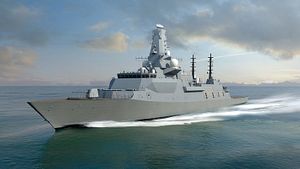After much anticipation, Australian Prime Minister Malcolm Turnbull announced that BAE Systems Australia’s Global Combat Ship or Type 26 is the preferred bidder to design the Royal Australian Navy (RAN)’s future frigate, named as the Hunter class. This was an extremely significant choice, as BAE Australia faced two other experienced and prominent competitors — Spain’s Navantia F-5000 and the French-Italian company Fincantieri’s FREMM design. In announcing the choice, Turnbull hailed the Type 26 as “one of the most advanced anti-submarine warships in the world” while British Prime Minister Theresa May praised the contract as the largest naval defense deal for the U.K. in a decade.
What does this deal mean for British relations with Australia and the wider Asia-Pacific region?
The BAE offer won out in part because of Australia’s economic consideration. Turnbull specifically stated that the new warships will be built by an Australian shipping yard, Osborne Naval Shipyard, and will secure 4,000 jobs in Australia. Australian industry will provide around 70 percent of the content and the ships will be constructed from Australian steel. This has led Scottish union workers — who currently are building the Royal Navy’s Type 26 City-class frigate — to criticize the entire deal as a substantial loss to British workers and taxpayers.
However, both the UK and Australia would benefit from this bid. Australia’s choice will lower the per unit price tag of the Type 26 frigate, providing yet further economic gains to BAE and the British economy.
As the preferred bidder, BAE’s Type 26 design will be leading in the technological and structural design for Australia’s ships. This will facilitate sharing information between shipbuilders; Australia will be able to de-risk their design and sea trials since the construction of its ships will begin at least five years after the construction of the Britain’s own Type 26 frigates begins.
The decision means that the U.K.’s City class and the Australian Hunter class will share several similar sensors and weapons, namely the towed-array Sonar 2087 system, the Phalanx close-in-weapons system, 30mm guns, the Mk41 vertical launch system and the Mk 45 five-inch gun and the mission bay. This will ease technological transfers between both countries and ship builders, especially with regards to Sonar 2087, which the Royal Navy has substantial experience with.
Finally, Australia’s choice of BAE Systems for the contract was influenced by British politicians, including the foreign secretary, his defense and international trade counterparts. The expectation is that this deal will help pave the way for a free trade agreement with Australia after the U.K. leaves the European Union. Another possibility might be that the U.K. in return, would favor Australian military equipment in its own purchases — the British Army is interested in Australia’s Bushmaster while the Royal Air Force is interested in the E-7A Wedgetail.
This frigate choice also boosts British defense and foreign policy in the Australasia-Asia-Pacific region. That means a total of 17 Type 26 anti-submarine warfare warships will be operating in the future, improving interoperability between the Royal Navy and the RAN. Australia’s choice the Type 26 will allow the Royal Navy to have a set of allied escort ships for its Queen Elizabeth-class carrier strike group. The U.K. has reduced its number Type 26 frigates from 13 to eight in its latest Strategic Defense and Security Review and will unlikely wish to order more of them. Australia’s nine future Type 26s, with similar systems and sensors, will be easily able to operate with the Royal Navy carrier strike group should it be in Asia-Pacific waters. Vice versa, Royal Navy Type 26s will also be easily able to fit in as escorts for a RAN task force deploying near the North Atlantic.
In a similar vein, this deal strengthens and reaffirms British defense relations with a key Commonwealth ally. It also indirectly strengthens the U.K.’s position in the Five Power Defense Arrangement (FPDA). The United Kingdom has often contributed small military teams to recent FPDA exercises due to budget cuts but Australia’s choice of a British design help indirectly reassert the U.K. role in this military pact.
The choice of this quiet anti-submarine design also directly improves Australia’s defense capability and aids U.K. defense intelligence. The Type 26 choice was made not only because of political considerations but certainly to counter the rise of Chinese submarines and China’s militarization of the South China Sea. Australia will not only be able to operate its new frigates close to China’s ships and facilities, but also be able to provide performance data to the Royal Navy, assisting them should they deploy their Type 26s to the region.
Australia’s choice may even lead to other navies also choosing the Type 26 design, further increasing the number of frigates based on the Type 26 in the Asia-Pacific. Canada is also look to replace their warships under the “Canadian Surface Combatant” project, with BAE System’ Type 26 as one of the three choices — the others being the Dutch De Zeven Provinciën-class frigate and Spanish F-105 frigate. Australia’s decision could influence Canada’s choice. If Canada does choose the BAE Type 26, there will be 32 Type 26 frigates operating globally, including in Asia-Pacific waters. It would also deepen the defense relationship between two core Commonwealth countries and the U.K., a goal of many Brexit proponents.
Australia’s choice of BAE System’s Type 26 will produce Australian jobs, use Australian steel, and utilize Australian industrial components. Nevertheless, the U.K. stands to gain through design ownership and technological sharing. Britain might benefit from a free trade deal in the future as well, but the decision will certainly significantly improve the U.K. defense relationship with Australia and improve London’s defense posture in the Asia-Pacific.
Li Jie Sheng is a freelance research analyst and writer with interests in Southeast Asian political economy, wider global political economy, multilateral organisations and international development.

































